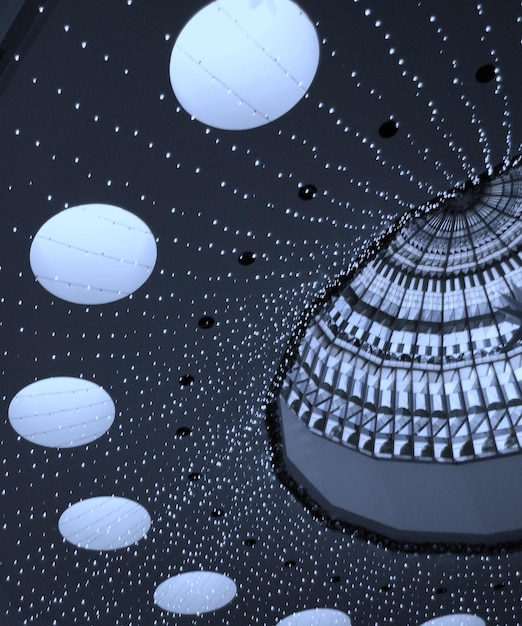Quick Read
7 Surprising Reasons Why Some People Still Believe in a Flat Earth: Debunking Common Myths and Misconceptions
Despite the overwhelming scientific evidence supporting a round Earth, there are still some individuals who cling to the belief in a flat earth theory. In this article, we will debunk seven surprising reasons why some people continue to hold onto this misconception.
Misunderstanding of Perspective
One common misconception is that people who believe in a flat earth don’t understand the concept of perspective. They argue that, from their vantage point on the ground, the Earth looks and feels flat. However, our planet is not a perfect disk but an oblate spheroid – slightly flattened at the poles and bulging at the equator.
Misinterpretation of Images
Another reason is the misinterpretation of images, particularly old maps and photographs. Some flat earthers claim that these depictions prove the Earth to be flat. However, it is important to note that many historical maps were not created with accurate geographical data and that early photographs often suffered from technical limitations.
Fear of Technology and Science
A third reason is a general fear or mistrust of technology and science. Flat earthers often argue that those who support a round Earth are part of an elite conspiracy to keep the truth hidden from the masses. However, this belief is based on unfounded assumptions and misinformation.
Lack of Education
A fourth reason is simply a lack of education or understanding of the scientific principles that prove the Earth’s roundness. Many people rely on anecdotal evidence and personal beliefs rather than factual information.
5. Confirmation Bias
A fifth reason is confirmation bias, the tendency to interpret new evidence as supporting one’s existing beliefs rather than considering alternative explanations. Flat earthers often disregard or dismiss evidence that contradicts their belief and focus only on information that seems to support it.
6. Misinformation Spread through Social Media
Social media plays a significant role in the persistence of flat earth beliefs. Misinformation and conspiracy theories can spread rapidly, often reaching large audiences before being debunked. This can create a sense of community among believers and reinforce their existing beliefs.
7. Emotional Connection to Simplistic Worldviews
Lastly, some people are emotionally invested in the idea of a flat Earth due to its simplicity and the sense of control it offers. The belief in a round Earth challenges their worldview, leading them to cling tightly to their flat earth beliefs despite evidence to the contrary.
Conclusion:
Understanding why some people still believe in a flat Earth requires acknowledging both the reasons behind their beliefs and the misconceptions that fuel them. By addressing these issues head-on, we can help promote a better understanding of our planet and its place in the universe.

Flat Earth Theory: Surprising Reasons Why It Persists
I. Introduction
The flat earth theory, a belief system positing that the Earth is not a sphere but a flat plane, has been a subject of fascination and controversy for centuries.
Brief explanation: Proponents of this theory argue that the Earth, instead of being a sphere as widely accepted by the scientific community, is an infinite and flat plane with various edges or borders.
Importance: Understanding the beliefs behind the flat earth theory is crucial for several reasons, primarily to foster open-mindedness, promote critical thinking, and provide context to various conspiracy theories.
Overview: In this exploration, we will delve into the seven most surprising reasons why some people still hold onto this belief.
Reason 1: Misunderstanding of Basic Science Concepts
Reason 1 for believing in a flat Earth theory is rooted in the misunderstanding and rejection of basic science concepts. Many people hold onto this belief despite overwhelming scientific evidence that clearly shows the Earth is round.
Description of Scientific Evidence for a Round Earth
A. One of the strongest pieces of evidence is the shape of the Earth’s shadow on the moon during a lunar eclipse. The roundness of this shadow is a clear indication that the Earth casting it is indeed spherical. Additionally, observations from space provide undeniable proof. B. Satellite imagery and photographs taken from the International Space Station show the curvature of the Earth, further solidifying the scientific consensus that our planet is round.
Misunderstanding and Rejection of Evidence
A. Unfortunately, some individuals fail to grasp these concepts due to a lack of formal education in science. However, even those with scientific knowledge can be misled by B. misconceptions about the scientific process and consensus. Some people believe that scientific theories are proven facts, when in reality they are merely hypotheses that have been extensively tested and supported by evidence.
Debunking Common Flat Earth Myths
Myth 1: The Roundness of the Earth’s Shadow on the Moon During a Lunar Eclipse
A. Some flat earthers argue that the roundness of the Earth’s shadow on the moon during a lunar eclipse is contradictory to the idea of a round Earth. However, this is not the case. The shape of the shadow is influenced by the shape of the object casting it – in this case, the round Earth.
Myth 2: Manipulated Space Photographs
A. Another common myth is the belief that photographs taken from space are fake or manipulated. However, numerous independent organizations and agencies have verified the authenticity of these images. Additionally, advancements in technology allow for more detailed and accurate photographs to be taken than ever before.

I Reason 2: Historical and Cultural Influences
Reason 2: The belief in a flat Earth is not solely based on modern misconceptions or lack of scientific knowledge. Instead, it is deeply rooted in historical and cultural influences that have shaped human perceptions for centuries.
Ancient Texts from Civilizations like the Greeks and Egyptians
Many ancient civilizations, including the Greeks and Egyptians, held beliefs about the Earth’s shape that contradict modern scientific knowledge. The Ancient Greek philosopher Ptolemy, for example, put forward a geocentric model of the universe with Earth at its center. This belief was widely accepted until the heliocentric theory proposed by Nicolaus Copernicus in the 16th century. Similarly, the Egyptians believed that Earth was flat and disc-shaped with four edges and a central mountain.
Religious Texts Describing a Flat Earth
Religious texts have also contributed to the persistence of the flat Earth belief. For instance, some passages in the Bible, particularly those describing the Earth as a disc or a flat plane, have been interpreted by some groups to support this notion.
Debunking Common Flat Earth Myths Related to This Reason
Myth 1: It is a common belief among flat Earthers that ancient civilizations knew more than modern science. However, it’s essential to understand that our current scientific understanding builds upon the knowledge and discoveries made by previous generations. While ancient civilizations held incorrect beliefs about Earth’s shape, they did not possess the advanced technology and methods we use today to gather accurate information about our planet.
Myth 2:
Myth 2: Another belief is that certain religious texts must be taken literally, even when they describe a flat Earth. It’s important to remember that religious texts are not always meant to convey scientific or geographical facts but rather spiritual or moral teachings.

Reason 3: Psychological Factors and Cognitive Biases
A significant portion of the belief in a flat Earth can be attributed to psychological factors and
Confirmation Bias
Confirmation bias, a well-documented phenomenon, refers to the tendency for people to favor information that confirms their existing beliefs and discount evidence that contradicts them. Flat Earth believers often seek out confirmatory evidence while dismissing or distorting disconfirmatory information, leading to a skewed understanding of the facts.
Anchoring Effect
Anchoring effect, another cognitive bias, plays a role when individuals rely too heavily on the first piece of information they receive (the “anchor”) when making subsequent judgments or decisions. For flat Earth believers, their initial belief in a flat Earth might serve as an anchor, causing them to discount any evidence that contradicts this belief and instead search for information that reinforces it.
Debunking Common Flat Earth Myths
The idea that scientific evidence is unreliable or manipulated
It’s important to understand that scientific evidence is not a monolith but rather an evolving collection of data and theories that are rigorously tested, debated, and refined over time. The consensus that the Earth is round has been supported by a wealth of evidence from various fields, including geology, astronomy, and physics. Flat Earth believers’ claims that this evidence is “manipulated” or “fabricated” lack substance and are not supported by facts.
Belief in conspiracy theories about governments and scientists hiding the truth
Flat Earth believers often point to various conspiracy theories as evidence that the scientific community is hiding the “truth” about a flat Earth. These theories, however, lack credible evidence and are based on misinterpretations or misunderstandings of scientific principles and data. The idea that governments and scientists would collude to suppress such an “obvious” truth is not supported by any factual evidence and is a baseless conspiracy theory.

Reason 4: Social Influence and Group Dynamics
Social influences and group dynamics play a significant role in shaping beliefs, even when those beliefs are contradictory to scientific evidence. One such belief is the flat Earth theory.
Desire for Uniqueness and Individuality:
People’s desire to be unique and different can contribute to the appeal of unconventional beliefs, such as a flat Earth. In today’s world dominated by mainstream scientific consensus, being part of a counterculture can be alluring. Flat Earth believers may feel that they are part of an exclusive club, distinguishing themselves from the “sheeple” who blindly accept scientific facts.
Appeal of Conspiracy Theories:
Social influences and group dynamics can also fuel the spread of conspiracy theories, including flat Earth beliefs. Humans have an innate desire to make sense of complex phenomena, and when traditional explanations seem insufficient or incomplete, alternative theories can emerge. Flat Earth conspiracy theories often involve a perceived manipulation of information by authorities, making believers feel like they possess hidden knowledge that the rest of the world is missing.
Creating a Sense of Community:
Social media and the internet have made it easier than ever for individuals holding unconventional beliefs to connect with one another. This can create a strong sense of community among flat Earth believers, reinforcing their beliefs despite scientific evidence to the contrary. In this closed environment, alternative explanations are validated, and dissenting voices are often silenced or dismissed.
Debunking Flat Earth Myths:
It’s important to debunk common myths related to social influences and group dynamics in the context of flat Earth beliefs.
Myth 1:
Being part of a flat Earth community is not a sign of intelligence or enlightenment, but rather an indication of being misinformed or deceived.
Myth 2:
Alternative explanations for natural phenomena do not necessarily hold more truth than scientifically accepted theories, especially when they are based on misinformation or erroneous assumptions.

VI. Reason 5: Misinterpretation of Data and Information
Description of how some people misinterpret data and information to support the flat Earth belief:
Some individuals holding the belief in a flat Earth often misconstrue scientific data and mathematical concepts related to our planet’s shape. This selective interpretation of information allows them to favor evidence that supports their beliefs while dismissing or ignoring contradictory data. For instance, they might cherry-pick specific findings from credible sources while disregarding the broader context or the consensus of the scientific community. Moreover, some flat Earthers face challenges in grasping advanced mathematical concepts, leading to a misunderstanding of the theories that describe our spherical Earth.
Explanation of how these misinterpretations can lead to flawed arguments and a rejection of scientific evidence:
Misinterpreting data and information can result in a series of flawed arguments that ultimately support the flat Earth belief. For example, these individuals may argue that mathematical models are inherently flawed or inaccurate. However, it is essential to understand that mathematical models serve as approximations of real phenomena and are not intended to replicate the exact physical reality. Furthermore, some flat Earthers propose alternative explanations for natural phenomena that contradict scientific consensus and lack supporting evidence.
Debunking common flat earth myths related to this reason:
The idea that mathematical models are flawed or inaccurate:
Mathematical models are crucial tools for scientists to understand and describe complex phenomena. While no model can perfectly capture reality, they provide valuable insights into the behavior of physical systems. In the context of Earth’s shape, mathematical models accurately represent our planet as a sphere within acceptable margins.
Belief in alternative explanations for natural phenomena:
Flat Earthers often propose alternative explanations for natural phenomena, such as the movement of celestial bodies, that are not supported by scientific evidence. For instance, they may argue that the Moon’s phases result from artificial illumination. However, such arguments contradict well-established scientific facts and are not backed by credible evidence.

VI. Reason 6: Misconceptions About Geography and Maps
Misconceptions about geography and maps have contributed significantly to the belief in a flat Earth theory. Some people harbor misunderstandings about longitude and latitude, two fundamental concepts essential for mapping the Earth’s surface.
Misunderstanding of Longitude and Latitude
Longitude refers to the east-west positioning of places on Earth, while latitude denotes the north-south positions. These concepts help establish a cartesian coordinate system for mapping locations worldwide. However, some individuals misunderstand these concepts and assume that longitude lines are evenly spaced meridians or that latitude circles are perfectly parallel. In reality, longitude lines converge at the poles and are not evenly spaced, while latitude circles are not parallel but do decrease in width as they approach the equator.
Belief that Maps are not Accurately Scaled or Represent the True Shape of the Earth
Some individuals argue that maps are intentionally misleading or inaccurate, which can lead them to question scientific evidence about the shape of the Earth. They often believe that maps do not accurately depict the true shape or size of countries, continents, or even the entire planet. However, it is important to note that most modern maps are produced using precise and scientific methods to provide accurate representations of geographical features.
Debunking Common Flat Earth Myths
Maps are Intentionally Misleading or Inaccurate
The belief that maps are intentionally misleading or inaccurate is simply unfounded. Maps are created using extensive research, geodetic surveys, and satellite imagery to ensure as accurate a representation as possible.
The Concept of Longitude and Latitude is Flawed or Based on Incorrect Assumptions
The concept of longitude and latitude is a fundamental component of geography and has been extensively studied and refined over centuries. It provides an accurate and effective way to locate places on Earth and create maps. The misconceptions surrounding longitude and latitude, such as the belief that lines are evenly spaced or parallel, are not based on factual evidence.

VI Conclusion
Seven Surprising Reasons for Flat Earth Belief: Despite overwhelming scientific evidence proving the Earth is round, some individuals continue to hold onto the belief in a flat Earth. Reasons range from religious or cultural beliefs, a desire for simplicity, to misunderstanding of scientific concepts. Others may be drawn to the idea due to social media influence, or simply because they enjoy the controversy. These beliefs not only hinder scientific progress but can also lead to dangerous consequences, such as rejecting critical safety measures based on a false understanding of Earth’s shape.
Importance of Critical Thinking, Scientific Literacy, and Open-Mindedness:
Debunking flat Earth myths requires a strong foundation in critical thinking, scientific literacy, and an open-minded approach to new information. By questioning assumptions and evaluating evidence objectively, we can separate fact from fiction. Critical thinking skills also help us distinguish between credible sources of information and those that may spread misinformation intentionally or unintentionally.
Continued Education, Dialogue, and Sharing Accurate Information:
To combat the spread of flat Earth misconceptions, it’s essential to continue educating ourselves and others about the scientific evidence supporting our planet’s true shape. Engage in dialogue with those who hold alternative beliefs, using respectful language and evidence-based arguments to challenge misconceptions. Share accurate information through reliable sources, such as scientific organizations, reputable news outlets, and educational institutions. By working together, we can promote a better understanding of our world and foster a culture of curiosity, learning, and truth.




